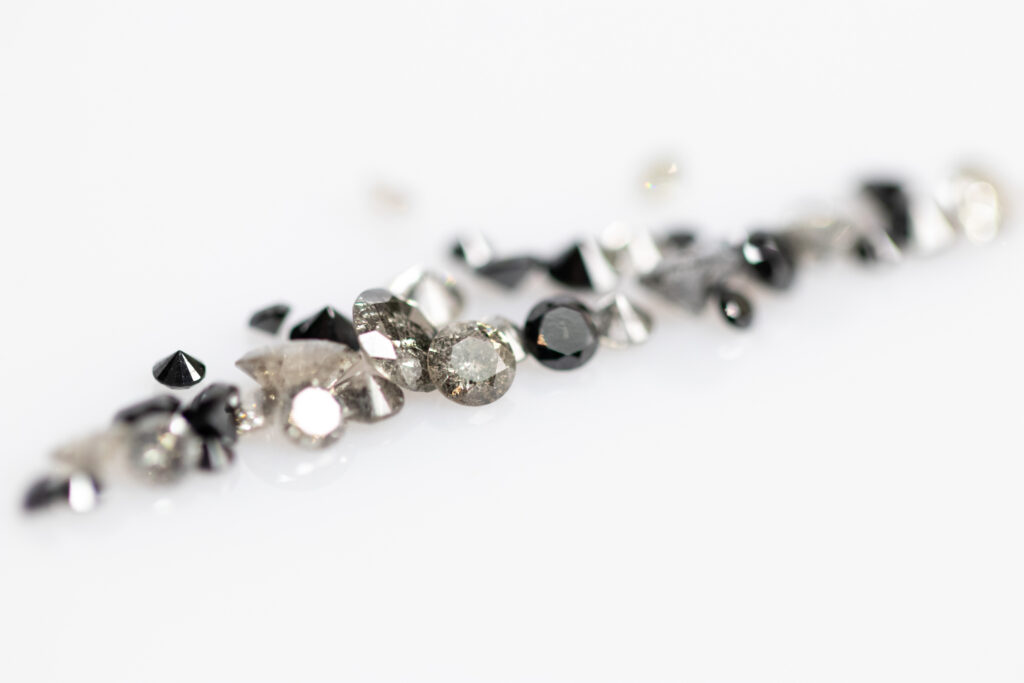For decades, there have been concerns as to the legitimacy of some diamond sources, and whether or not they’re ethical – but does this include salt and pepper diamonds?
There is nothing inherently unethical about a salt and pepper diamond, but they might not always be conflict-free diamonds. However, lots of salt and pepper diamonds are totally conflict-free, ethical, or in many cases, lab-grown, which is the most ethical method there is.

Read on to learn more about salt and pepper diamonds, what they actually are, and how much they tend to cost.
It’s A Diamond, Not A Condiment
When you hear the term ‘salt and pepper diamond’, you might have already conjured up the obvious image it brings to mind. Well, you’re probably right, as a salt and pepper diamond is merely a diamond that has black, pepper-like flecks throughout it.
These flecks are known as ‘inclusions’, and they can spell bad luck for almost any gemstone – except emeralds, which are well known for their inclusions. In fact, we wrote an article about the inclusions you can find in an emerald, and what that means for the stone.
So, what is an inclusion?
Put simply, an inclusion is a thing that occurs within the stone as it develops over the course of hundreds of millions of years. This could be an air bubble, the introduction of a rogue element, or some other foreign body that causes a crack, fissure, fracture, or discoloration.
Salt and pepper diamonds, though – they’re exactly the same as a regular diamond, composition and all, except for one thing. As the diamond has ‘grown’, the extreme levels of heat and pressure cause widespread inclusions throughout the stone itself.
The end result is a diamond that doesn’t really sparkle, owing to the rampant black peppering that exists throughout its core. However, that doesn’t mean that the diamond is instantly made worthless – it can still be treated as a salt and pepper diamond.
They’re also known as rustic, rough, or natural diamonds, even if they’re grown in a lab environment, and they’re much cheaper than standard, high-quality diamonds. They command a much lower price because they’re not as beautiful, but they certainly are unique.
These inclusions will differ from stone to stone, meaning you’re never going to see the exact same salt and pepper diamond twice. Furthermore, a salt and pepper diamond can still be a perfectly fine size, as again, it grows in the same way as a regular diamond.
But Are They Ethical?
If any diamond is grown in a lab environment, it’s almost inherently ethical, as the process considers both the industry and the environment. However, diamonds taken ‘from the wild’ are often a little riskier, unless you can trace them back to their source.
And, with many modern diamond cutters, jewelers, or manufacturers, that’s exactly how it works.
It’s important to seek certification when buying an expensive diamond, and many retailers or jewelers will be more than happy to provide it. It authenticates the diamond as being conflict-free, or as ethical as you could possibly hope for.
This is the same for any diamond, but in this case, it certainly applies to salt and pepper diamonds. More often than not, you can be sure that your salt and pepper diamond is ethical, and conflict-free.
However, it is a slippery slope in the jewelry world, and you cannot rely on certification alone – after all, it’s extremely easy to deceive someone regarding the source of something. There are some jewelers who insist that salt and pepper diamonds are less commonly conflict-free, but it’s a subject for debate.
The Black Diamond
In some cases, a salt and pepper diamond can have so many inclusions that it becomes more black in appearance than anything else. There are suggestions that these black diamonds are almost always the conflicted variant, but there are alternatives you can pick from if you don’t want to take the chance.
For instance, you could opt for a moissanite stone that also bears inclusions – it’s the closest stone on Earth to a diamond, after all. Alternatively, you could pick a black spinel, or a supreme, dark-blue sapphire from Australia.
There are plenty of options out there if you’re being wary and trying to actively avoid any possibility of picking up an unethical diamond. However, if you do want a salt and pepper diamond, there are steps you can take to avoid purchasing a non conflict-free stone.
